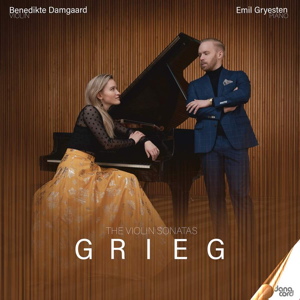
Edvard Grieg (1843-1907)
Violin Sonata No. 1 in F major, op.8 (1865)
Violin Sonata No. 2 in G major, op.13 (1867)
Violin Sonata No. 3 in C minor, op.45 (1887)
Duo Damgaard-Gryesten
rec. 2023, Hjørring Gymnasium, Hjørring, Denmark
Danacord DACOCD964 [66]
Edvard Grieg is remembered for orchestral suites, the ubiquitous but accomplished piano concerto, and many short piano pieces and songs. On the other hand, his catalogue has precious few chamber works. Most significant are the Sonata in A minor for cello and piano and the String Quartet in G minor. There are also the first two movements of an incomplete String Quartet in F major, a lost String Quartet in D minor, a short Gavotte for violin and piano, and an Andante in C minor for piano trio.
Grieg’s most substantial contribution to chamber music are the three Violin Sonatas. He is said to have been proud them: “They represent periods in my development – the first naïve, rich in ideas; the second national; the third with a wider horizon.” The liner notes elaborate on this assessment. The Sonatas encapsulate Grieg’s journey from a young man learning his craft by absorbing the “heritage of the classicist composers” in the first sonata, through national romantic music in the second, to a full realisation of his artistic powers in the third.
The Violin Sonata No. 1 was composed whilst Grieg was staying at the seaside town of Rungstead north of Copenhagen. It has been noted that Niels Gade and Franz Liszt were impressed. Although written in the classic sonata form, it has several interesting quirks. Ostensibly in F major, the first movement opens in E minor (one sharp) before discovering the home key. Another point of interest is a short Andante segment in the development section. There is no slow movement. The Allegretto quasi andantino, in the guise of a minuet, acts as a kind of scherzo complete with “hardanger fiddle effects”. For me, the most impressive movement is the brilliant and virtuosic Allegro molto vivace, built on three themes and subject to many changes of mood and technical devices. The jovial opening bars are followed by “a mysterious brooding theme” and then a sweet nostalgic tune. After a short fugato, the movement ends full of cheerfulness.
Norwegian composer Gerhard Schjelderup described this sonata as the “work of a youth who has known only the sunny side of life”. Yet there are many darker and more turbulent moments, pointing to Grieg’s developing maturity. It is unsurprising that overall this sonata will remind the listener of Mendelssohn and Schumann. Liszt described it as “vigorous, reflective, inventive, and full of excellent material”.
Grieg finished the Violin Sonata No. 2 when he was living in Kristiania (now Oslo). To appreciate this piece, it is necessary to recall the influence of the Norwegian violin virtuoso Ole Bull. He was to encourage Grieg to combine Nordic folk music with the then prevalent romantic tradition. Grieg wrote that Bull “opened my senses towards the beauty of Norwegian music. From him I learned many forgotten folk tunes and, above all, my own nature.”
The Sonata begins with a rhapsodic prelude before the first theme takes on the character of an animated “springar” (leaping) dance, followed by a sad second subject. The second movement Allegretto tranquillo combines a general feeling of melancholy with “passionate outbursts”. The Allegro animato finale balances a fast, energetic waltz with one that is introverted and dreamy, even becoming tragic. After the reprise of the opening theme, the coda presents the slow waltz again as confident and brash.
The Violin Sonata No. 3 was Grieg’s last major chamber work. He has by then moved on with his personal musical aesthetic. It is easy to hear the influence of Richard Wagner, Johannes Brahms and César Franck. The “overt folklorism” of his earlier sonatas has been sublimated into the “wider horizons” of Western classical music that Grieg aspired to. There is passion in the opening bars before the subdued theme emerges. This does not triumph, and the movement ends in heartbreak. Things change in the beautiful Alla Romanza, really a love song without words. The middle section is more restless. The liner notes suggest that the finale is like “a Norwegian inspired dance macabre”: it may reflect stormy sea music inspired by Wagner’s The Flying Dutchman. There is a moment of calm, and then of agony and turbulence, before Grieg introduces a long-breathed cantabile. A feverish coda brings this remarkable Sonata to a triumphant and optimistic conclusion.
Pianist Emil Gryesten’s comprehensive liner notes are a great introduction to Grieg’s three violin sonatas. He examines each work’s background snd supplies a readable technical analysis. Let me acknowledge my debt to this fine essay.
The Duo Damgaard-Gryesten was formed some ten years ago by two students – Benedikte Damgaard (violin), Emil Gryesten (piano) – at the Royal Danish Academy of Music. They performed as far afield as the Faroe Islands and Vietnam. They won prizes at the Jacob Gade Violin Competition, the Nordic Piano Competition, and the Val Tidone International Chamber Music Competition. Their recent achievement was a presentation of Beethoven’s complete Violin Sonatas in the recital room. Individually and together they have issued at least nine discs of solo and ensemble works, including music by Richard Strauss, Friedrich Kuhlau and Karol Szymanowski.
The key to a satisfactory performance of Grieg’s Violin Sonatas is an ability to synthesise the folk music passages with the broader elements of romantic musical language. There also needs to be a well-judged balance between confidence, simplicity and a sense of Nordic tragedy in each sonata’s progress. I believe that these artists step up to the plate. I did not know the Sonatas well, but the recital has opened my eyes to these splendid pieces.
John France
Help us financially by purchasing from




















